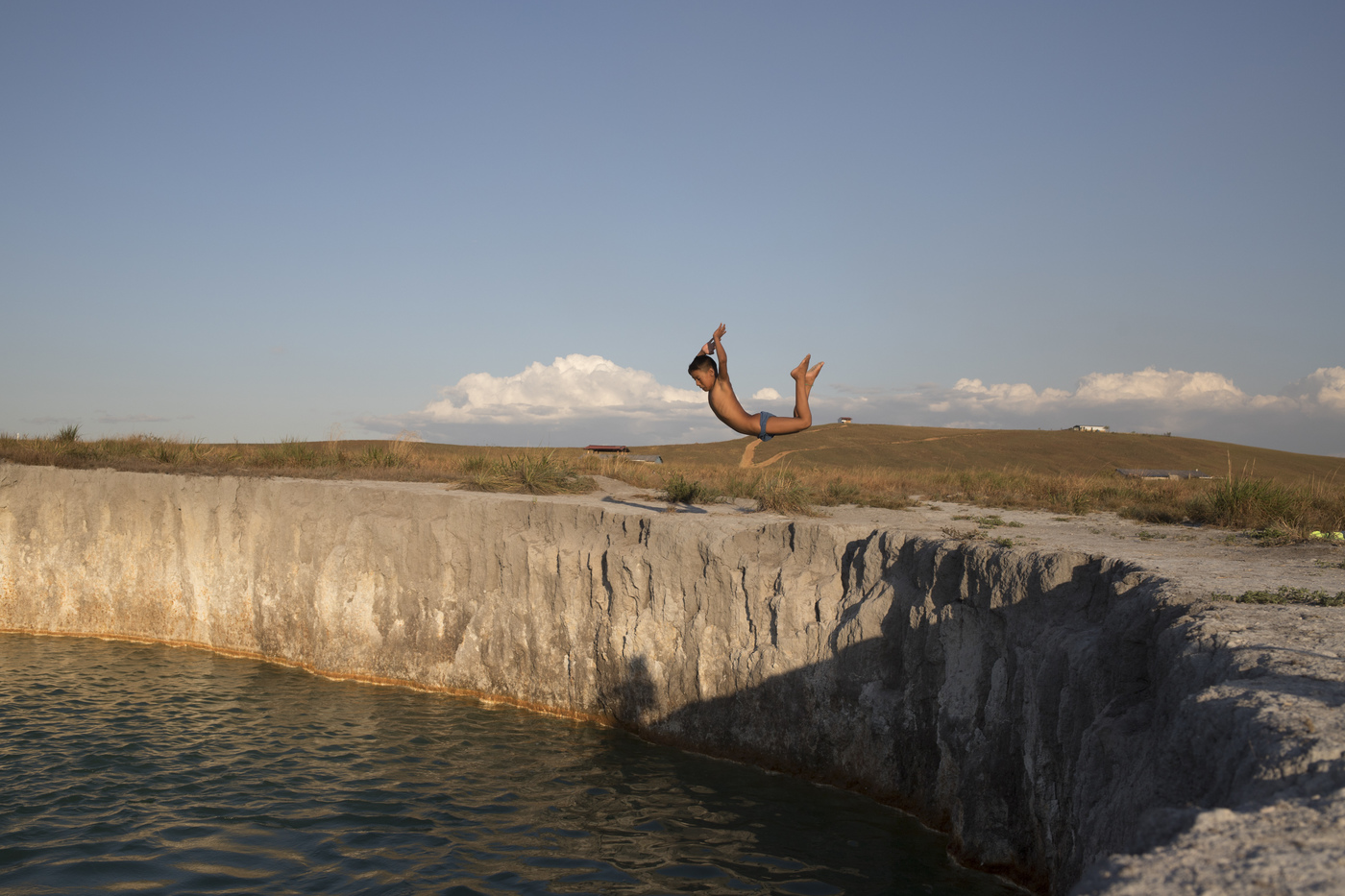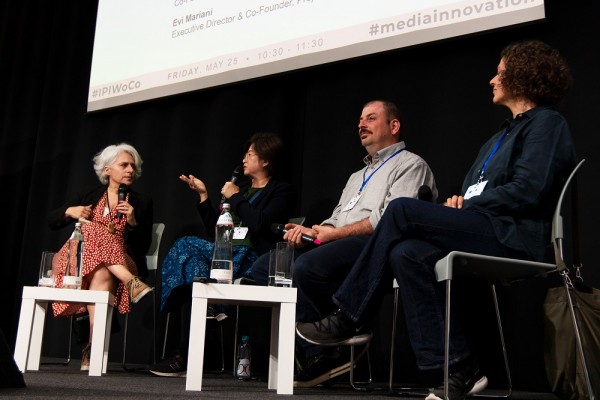It’s a photo that tells clashing stories: on its surface, the idyll of a water-side childhood; underneath, the destructive pollution from mining.
It’s Fabiola Ferrero’s shot from deep in the immensity of the Gran Sabana in Venezuela’s south, capturing a Pemón child floating mid-air as he dives from steep banks into an almost magically blue lagoon. But, as journalist María de los Ángeles Ramírez explains: “The lagoon was formed by mining. It is polluted.” That eye-catching blue? That’s caused by mercury and other heavy metals, motor oil and gasoline, all the result of gold mining.
This is the Campo Alegre pit in the Canaima National Park, which has destroyed some 78 hectares of this area close to Mount Roraima where Brazil, Venezuela and Guyana meet.
The photo comes from the work of Ramirez and Ferrero as they travelled across the vast park for the region’s local paper Correo del Caroní, in the journalistic project Gold mining devastation beneath the eyes of the Roraima Tepuy. Campo Alegre is just another mining pit on a map dotted with gold mines proliferating like mushrooms along the course of the rivers in this 3 million-hectare national park.
Officially, mining is banned in the national Park. But the “garimpeiros”, (originally a Brazilian word for illegal miners) have invaded the Gran Sabana.
The work of Ramírez and Ferrero was part of a far bigger undertaking that sought to answer a big journalistic question: how do you anchor the information needs of your local community within the overwhelming global story of environmental destruction and the climate crisis?
The answer? National and transnational collaboration. For their look at the devastation of gold mining, Correo del Caroní linked with the Pulitzer Center, the website ProDavinci.com from Caracas and the investigative platform InfoAmazonia.org, from São Paulo, Brazil.
In a separate project it linked with another of Venezuela’s leading digital news sites, Runrun.es, as part of a year-long project with De Correspondent from the Netherlands, and The Miami Herald/El Nuevo Herald from the US.
The result was Venezuela, the smuggler´s paradi$e, led globally by Dutch journalist Bram Ebus, which tells the story of the five-fold population increase in El Callao, in Bolivar State, about 170 kilometres south-west of Correo del Caroni’s home base in Ciudad Guayana. It’s a modern gold rush: In less than ten years, some 500,000 people have flooded into the area, including criminal gangs, ELN guerrillas, FARC dissidents, and corrupt military attempting to control and extract value from the mines.
Launched as a traditional print paper in 1977, El Correo del Caroni, brought local input. Based in Ciudad Guayana where the Rio Caroni meets South America’s second largest river (by volume), the Orinoco, the masthead’s journalists have long focussed on the environmental devastation being caused by work in the National Strategic Development Zone of the Orinoco Mining Arc. Known as the Orinoco Mining Arc, it absorbed the Orinoco Belt where most of the country’s petroleum reserves are found, extending it to some 118,834 square kilometres (about the size of mainland Greece).
“Since 2016, when the Orinoco Mining Arc was created, a big explosion of illegal mining ensued,” says Ramirez. The situation, she says, has brought criminal groups, a huge environmental impact and violations of the human rights of indigenous people and garimpeiros.
Alicia Estaba, the current editor-in-chief, says that Correo del Caroní began to face problems when Hugo Chávez first became president at the turn of the century. Capital linked to the regime tried (unsuccessfully) to buy the paper out, the newspaper lost advertising from public institutions and was blocked from buying printing paper.
In the end, they opted to survive by going digital, relying for funding on the little advertising they managed to get in a collapsing economy. It now has eight journalists and two interns to report across the three states of Guayana (Delta Amacuro, Amazonas and Bolivar), a hard-to-access area in the south and east covering about 40 percent of the country. The Correo has endured police raids and lawsuits. Getting around has become expensive and difficult; fuel is scarce, and what is available goes to mining.
For El Correo that meant collaboration was essential. The masthead joined with Runrun.es to produce a special report on the Mining Arc. Ramírez joined Lisseth Boon and Lorena Meléndez to travel 800 kilometres along the Trunk Road 10 that runs from Ciudad Guayana to Pacaraima, in Brazil’s Roraima federal state. They uncovered a universe of opaque public, mixed and private companies: some just mailing addresses, others involved in corruption, detentions and assassinations. They reported that most mines are controlled by crime syndicates and gold is smuggled out leaving few benefits for the marginalised miners, who live in slums surrounding the pits.
According to Ramirez, these are “miners who work in slave-like conditions”. Estaba speaks of women kidnapped to do domestic work in the camps, and of garimpeiros who are not allowed to leave.
Accelerated deforestation “also has to do with mining”, says Ramírez, “because more people are moving to these areas deforesting for mining… they also have to clear vegetation to build their houses and plant crops…” On both sides of the main route through the region, Trunk Road 10, invaded and deforested areas with makeshift camps line the landscape.
But where does all the gold go? Gold from the Mining Arc and the Yapacana National Park in Amazonas State is taken by land, by boat or by plane to Colombia and the Antilles, to disguise its origin and continue to Miami, Switzerland, Holland and other destinations, while authorities and airlines look away. Refugees from Venezuela’s humanitarian crisis are used as mules in the smuggling, often under extortion and threats to their families. On the Colombian-Venezuelan border, indigenous people are exposed to mercury contamination, malaria and violence from armed groups.
As a local voice, El Correo del Caroni had to think, too, about how to build local impact beyond its immediate digital distribution. With its coverage of mercury contamination, Correo del Caroní implemented a field strategy of printing the information they’d gathered as posters and taking them to the indigenous communities in the area.
Want more? Read part one here and three here.
Andrés Schäfer is a Madrid-based freelance researcher and journalist. You can see more of his stories for IPI here.
IPI’s Local Media Project is telling the stories of how local media around the world are reinventing everything to better serve their audiences and fulfil their key role in democracy. This article is part of our series profiling innovative local news publishers.



